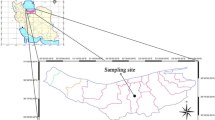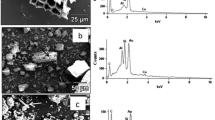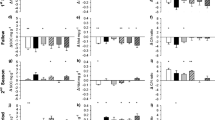Abstract
Background and aims
Soil incorporation of charcoal (biochar) has been suggested as practice to sequester carbon, improve soil properties and crop yields but most studies have been done in the short term. Old anthropogenic charcoal-rich soils in the Alps enable to explore the long-term impact of charcoal addition to alpine grassland on seed germination, fertility and fodder nutritive value.
Methods
A germination test and a growth experiment in pots with Festuca nigrescens Lam. and Trifolium pratense L. were performed using three different substrates: control soil (i.e. sandy-loam brown acid soils with some podsolization), charcoal hearth soil (i.e. charcoal-enriched anthropogenic soils derived from the carbonization of larch wood on flat terraces) and control soil mixed with a fraction of fresh larch wood charcoal to reach the soil-charcoal ratio of 0.6.
Results
Both aged and fresh charcoal improved germination and markedly increased plant growth of the two plant species. The addition of fresh charcoal had an initial detrimental effect that disappeared in the second and third growth cycles. Plant Nitrogen:Phosphorus ratio revealed that growth was N-limited in the anthropogenic soils and P-limited in the control and freshly amended soils demonstrating that biochar aging is critical to obtain a significant growth stimulation. Plant nutrient contents revealed an improved fodder quality in both the charcoal amended soils.
Conclusions
Despite the occurrence of limited toxic effects on seedlings, larch wood charcoal appears to have positive effects on fertility and fodder quality of alpine grasslands in the long term.







Similar content being viewed by others
References
Agren GI, Franklin O (2003) Root: shoot ratios, optimization and nitrogen productivity. Ann Bot 92:795–800. doi:10.1093/aob/mcg203
Aronson J, Floret C, LeFloc’h E, et al. (1993) Restoration and Rehabilitation of Degraded Ecosystems in Arid and Semi-Arid Lands. I. A View from the South. Restor Ecol 1:8–17
Backmeroff, C (2013) Precisely dating iron-ore mining and its effects on an alpine valley: Summary of a dendrochronological investigation of charcoal hearths and relict woodland stands. In: Silvertant J ed. (ed) Min Cult Landsc – 8th Int Symp Archaeol Min Hist pp 218–251
Bargmann I, Rillig MC, Buss W, et al. (2013) Hydrochar and biochar effects on germination of spring barley. J Agron Crop Sci 199:360–373. doi:10.1111/jac.12024
Belleri, C (2014) L’Oasi di Protezione faunistica del Baremone: analisi e sviluppi
Bergametti G, Remoudaki E, Losno R, et al. (1992) Source, transport and deposition of atmospheric phosphorus over the northwestern Mediterranean. J Atmos Chem 14:501–513
Biederman LA, Harpole WS (2013) Biochar and its effects on plant productivity and nutrient cycling: a meta-analysis. GCB Bioenergy 5:202–214. doi:10.1111/gcbb.12037
Bovolenta, S, Dovier, S, Parente, G (2011) Dairy production systems in the Italian alpine area. Proceeding 16 th Meet. FAO CIHEAM Mt. Pastures Netw. Kraków, Poland, pp 137–140
Brugnoli E, Hubick KT, von Caemmerer S, et al. (1989) Correlation between the carbon isotope discrimination in leaf starch and sugars of C3 plants and the ratio of intercellular and atmospheric partial pressures of carbon dioxide. Plant Physiol 88:1418–1424. doi:10.1104/pp.88.4.1418
Case SDC, McNamara NP, Reay DS, Whitaker J (2012) The effect of biochar addition on N2O and CO2 emissions from a sandy loam soil – the role of soil aeration. Soil Biol Biochem 51:125–134. doi:10.1016/j.soilbio.2012.03.017
Chen W, Cui P, Sun H, et al. (2009) Comparative effects of salt and alkali stresses on organic acid accumulation and ionic balance of seabuckthorn ( Hippophae rhamnoides L. Ind Crop Prod 30:351–358. doi:10.1016/j.indcrop.2009.06.007
Ciais P, Soussana JF, Vuichard N, et al. (2010) The greenhouse gas balance of European grasslands. Biogeosci Discuss 7:5997–6050. doi:10.5194/bgd-7-5997-2010
Criscuoli I, Alberti G, Baronti S, et al. (2014) Carbon sequestration and fertility after centennial time scale incorporation of charcoal into soil. PLoS One 9:e91114. doi:10.1371/journal.pone.0091114
de la Rosa JM, Knicker H (2011) Bioavailability of N released from N-rich pyrogenic organic matter: an incubation study. Soil Biol Biochem 43:2368–2373. doi:10.1016/j.soilbio.2011.08.008
Di Lonardo S, Vaccari FP, Baronti S, et al. (2013) Biochar successfully replaces activated charcoal for in vitro culture of two white poplar clones reducing ethylene concentration. Plant Growth Regul 69:43–50. doi:10.1007/s10725-012-9745-8
Dullinger S, Dirnbock T, Greimler J, Grabherr G (2003) A resampling approach for evaluating effects of pasture abandonment on subalpine plant species diversity. J Veg Sci 14:243–252
Fang Y, Singh B, Singh BP (2015) Effect of temperature on biochar priming effects and its stability in soils. Soil Biol Biochem 80:136–145. doi:10.1016/j.soilbio.2014.10.006
FAO (1987) Simple technologies for charcoal making. Mechanical Wood Products Branch Forest Industries Division FAO Forestry Department, Rome
FAO (2002) FAO irrigation and drainage paper 61 Agricultural drainage water management in arid and semi-arid areas. Rome, Italy
Farquhar G, Richards R (1984) Isotopic composition of plant carbon correlates with water-use efficiency of wheat genotypes. Aust J Plant Physiol 11. doi:10.1071/PP9840539
Flachowsky, G, Jeroch, H, Kirchgessner, M, et al. (2001) Empfehlungen zur Energie- und Nahrstoffversorgung der Milchkuhe und Aufzuchtrinder. (Recommendations for the energy- and nutrient supply of dairy cows and breeding cattle). DLG-Verlag GmbH, Frankfurt am Main, Germany
Flematti GR, Ghisalberti EL, Dixon KW, Trengove RD (2004) A compound from smoke that promotes seed germination. Science 305:977. doi:10.1126/science.1099944
Flematti, GR, Ghisalberti, EL, Dixon, KW, Trengove, RD (2008) Germination stimulant in smoke: isolation and identification. Bioact. Nat. Prod. Detect. Isol. Struct. Elucidation
Flematti GR, Scaffidi A, Dixon KW, et al. (2011) Production of the seed germination stimulant karrikinolide from combustion of simple carbohydrates. J Agric Food Chem 59:1195–1198. doi:10.1021/jf1041728
Fontana V, Radtke A, Bossi Fedrigotti V, et al. (2013) Comparing land-use alternatives: using the ecosystem services concept to define a multi-criteria decision analysis. Ecol Econ 93:128–136. doi:10.1016/j.ecolecon.2013.05.007
Gamper SM, Tasser E, Tappeiner U (2007) Short-time effects of land-use changes on O-horizon in subalpine grasslands. Plant Soil 299:101–115. doi:10.1007/s11104-007-9366-6
Garnett E, Jonsson LM, Dighton J, Murner K (2004) Control of pitch pine seed germination and initial growth exerted by leaf litters and polyphenolic compounds. Biol Fertil Soils 40:421–426. doi:10.1007/s00374-004-0801-z
Gell K, van Groenigen J, Cayuela ML (2011) Residues of bioenergy production chains as soil amendments: immediate and temporal phytotoxicity. J Hazard Mater 186:2017–2025. doi:10.1016/j.jhazmat.2010.12.105
Genesio L, Miglietta F, Lugato E, et al. (2012) Surface albedo following biochar application in durum wheat. Environ Res Lett 7:014025. doi:10.1088/1748-9326/7/1/014025
Genesio L, Vaccari FP, Miglietta F (2016) Black Carbon aerosol from biochar threats its negative emission potential. Glob Chang Biol. doi:10.1111/gcb.13254
Glaser B, Haumaier L, Guggenberger G, Zech W (2001) The “Terra Preta” phenomenon: a model for sustainable agriculture in the humid tropics. Naturwissenschaften 88:37–41. doi:10.1007/s001140000193
Graber ER, Tsechansky L, Mayzlish-Gati E, et al. (2015) A humic substances product extracted from biochar reduces Arabidopsis root hair density and length under P-sufficient and P-starvation conditions. Plant Soil 395:21–30. doi:10.1007/s11104-015-2524-3
Greenway H, Munns R (1980) Mechanisms of salt tolerance in nonhalophytes. Annu Rev Plant Physiol 31:149–190
Grigulis K, Lavorel S, Krainer U, et al. (2013) Relative contributions of plant traits and soil microbial properties to mountain grassland ecosystem services. 47–57. doi:10.1111/1365–2745.12014
Güereña DT, Lehmann J, Thies JE, et al. (2015) Partitioning the contributions of biochar properties to enhanced biological nitrogen fixation in common bean (Phaseolus vulgaris. Biol Fertil Soils 51:479–491. doi:10.1007/s00374-014-0990-z
Hernandez-Soriano MC, Kerré B, Goos P, et al. (2015) ) Long-term effect of biochar on the stabilization of recent carbon: soils with historical inputs of charcoal. Glob Chang Biol Bioenergy 8:371–381. doi:10.1111/gcbb.12250
Hille, B (1992) Ionic Channels of Excitable Membranes, 2nd edition. Sinauer
Hille M, Den Ouden J (2005) Charcoal and activated carbon as adsorbate of phytotoxic compounds a comparative study. OIKOS 108:202–207
Hunziker M (1995) The spontaneous reafforestation in abandoned agricultural lands: perception and aesthetic assessment by locals and tourists. Landsc Urban Plan 1:399–410
Jeffery S, Verheijen FGA, van der Velde M, Bastos AC (2011) A quantitative review of the effects of biochar application to soils on crop productivity using meta-analysis. Agric Ecosyst Environ 144:175–187. doi:10.1016/j.agee.2011.08.015
Jenkins JR, Viger M, Arnold EC, et al. (2016) Biochar alters the soil microbiome and soil function: results of next generation amplicon sequencing across Europe. GCB Bioenergy. doi:10.1111/gcbb.12371
Johansson, K (2008) Salt to ruminants and horses. SLU, Dept. of Animal Nutrition and Management, Uppsala
Juknevičius S, Sabiené N (2007) The content of mineral elements in some grasses and legumes. Ekologija 53:44–52
Kessler, J (2001) Mineralstoffversorgung der Milchkuh auf einen Blick rap aktuell (Mineral nutrient supply of dairy cows at a glance). Villars-sur-Glane
Kloss S, Zehetner F, Dellantonio A, et al. (2012) Characterization of slow pyrolysis biochars: effects of feedstocks and pyrolysis temperature on biochar properties. J Environ Qual 41:990–1000. doi:10.2134/jeq2011.0070
Koerner C, Renhardt U (1987) Dry matter partitioning and root length / leaf area ratios in herbaceous perennial plants with diverse altitudinal distribution. Oecologia 74:411–418
Koerselman W, Meuleman AFM (1996) The vegetation N: P ratio: a new tool to detect the nature of nutrient limitation. J Appl Ecol 33:1441–1450
Kołtowski M, Oleszczuk P (2015) Toxicity of biochars after polycyclic aromatic hydrocarbons removal by thermal treatment. Ecol Eng 75:79–85. doi:10.1016/j.ecoleng.2014.11.004
Kopittke PM, Menzies NW (2007) A review of the use of the basic cation saturation ratio and the “ideal” soil. Soil Sci Soc Am J 71:259–265. doi:10.2136/sssaj2006.0186
Krahulec F, Skálová H, Herben T, et al. (2001) Vegetation changes following sheep grazing in abandoned mountain meadows. Appl Veg Sci 4:97–102. doi:10.1111/j.1654-109X.2001.tb00239.x
Kuppusamy S, Thavamani P, Megharaj M, et al. (2016) Agronomic and remedial benefits and risks of applying biochar to soil: current knowledge and future research directions. Environ Int 87:1–12. doi:10.1016/j.envint.2015.10.018
Lehmann J, Gaunt J, Rondon M (2006) Bio-char sequestration in terrestrial ecosystems – a review. Mitig Adapt Strateg Glob Chang 11:395–419. doi:10.1007/s11027-005-9006-5
Liang B, Lehmann J, Solomon D, et al. (2006) Black carbon increases cation exchange capacity in soils. Soil Sci Soc Am J 70:1719. doi:10.2136/sssaj2005.0383
Lim TJ, Spokas KA, Feyereisen G, Novak JM (2016) Predicting the impact of biochar additions on soil hydraulic properties. Chemosphere 142:136–144. doi:10.1016/j.chemosphere.2015.06.069
Makoto K, Choi D, Hashidoko Y, Koike T (2011) The growth of Larix gmelinii seedlings as affected by charcoal produced at two different temperatures. Biol Fertil Soils 47:467–472. doi:10.1007/s00374-010-0518-0
Mäser P, Gierth M, Schroeder JI (2002) Molecular mechanisms of potassium and sodium uptake in plants. Plant Soil 247:43–54
Maurer, K (2005) Natural and anthropogenic determinants of biodiversity of grasslands in the Swiss Alps. Universität Basel
Muller S, Dutoit T, Alard D, Grévilliot F (1998) Restoration and rehabilitation of species-rich grassland ecosystems in France: a review. Restor Ecol 6:94–101
Naisse C, Girardin C, Davasse B, et al. (2014) Effect of biochar addition on C mineralisation and soil organic matter priming in two subsoil horizons. J Soils Sediments 15:825–832. doi:10.1007/s11368-014-1002-5
National Research Council (2001) Nutrient Requirements of Dairy Cattle, 7th revise. National Academy Press, Washington, D.C
Nelson DC, Flematti GR, Ghisalberti EL, et al. (2012) Regulation of seed germination and seedling growth by chemical signals from burning vegetation. Annu Rev Plant Biol 63:107–130. doi:10.1146/annurev-arplant-042811-105545
Novak J, Sigua G, Watts D, et al. (2016) Biochars impact on water infiltration and water quality through a compacted subsoil layer. Chemosphere 142:160–167. doi:10.1016/j.chemosphere.2015.06.038
Ogawa M, Okimori Y (2010) Pioneering works in biochar research , Japan. Aust J Soil Res 48:489–500
Poeplau C, Don A (2013) Sensitivity of soil organic carbon stocks and fractions to different land-use changes across Europe. Geoderma 192:189–201. doi:10.1016/j.geoderma.2012.08.003
Poschlod P, Wallisdevries MF (2002) The historical and socioeconomic perspective of calcareous grasslands — lessons from the distant and recent past. Biol Conserv 104:361–376
Pusceddu E, Criscuoli I, Miglietta F (2013) Morphological investigation and physical characterization of ancient fragments of pyrogenic carbon. J Phys Conf Ser 470. doi:10.1088/1742-6596/470/1/012003
Reid RL, Horvath DJ (1980) Soil chemistry and mineral problems in farm livestock. A review. Anim Feed Sci Technol 5:95–167
Riedener E, Rusterholz H-P, Baur B (2013) Effects of different irrigation systems on the biodiversity of species-rich hay meadows. Agric Ecosyst Environ 164:62–69. doi:10.1016/j.agee.2012.09.020
Rombolà AG, Marisi G, Torri C, et al. (2015) Relationships between chemical characteristics and phytotoxicity of biochar from poultry litter pyrolysis. J Agric Food Chem 63:6660–6667. doi:10.1021/acs.jafc.5b01540
Rondon MA, Lehmann J, Ramírez J, Hurtado M (2006) Biological nitrogen fixation by common beans (Phaseolus vulgaris L.) increases with bio-char additions. Biol Fertil Soils 43:699–708. doi:10.1007/s00374–006-0152-z
Schachtman D, Liu W (1999) Molecular pieces to the puzzle of the interaction between potassium and sodium uptake in plants. Trends Plant Sci 4:281–287
Schimmelpfennig S, Müller C, Grünhage L, et al. (2014) Biochar, hydrochar and uncarbonized feedstock application to permanent grassland—effects on greenhouse gas emissions and plant growth. Agric Ecosyst Environ 191:39–52. doi:10.1016/j.agee.2014.03.027
Schimmelpfennig S, Kammann C, Moser G, et al. (2015) Changes in macro- and micronutrient contents of grasses and forbs following Miscanthus x giganteus feedstock, hydrochar and biochar application to temperate grassland. Grass Forage Sci 70:582–599. doi:10.1111/gfs.12158
Smith, RT, Atkinson, K (1975) Techniques in pedology. Paul Elek (Scientific Books) Ltd., London
Sohi, S, Lopez-Capel, E, Krull, E, Bol, R (2009) Biochar , climate change and soil: A review to guide future research
Solaiman ZM, Murphy DV, Abbott LK (2011) Biochars influence seed germination and early growth of seedlings. Plant Soil 353:273–287. doi:10.1007/s11104-011-1031-4
Solaiman ZM, Murphy DV, Abbott LK (2012) Biochars influence seed germination and early growth of seedlings. Plant Soil 353:273–287
Spokas KA, Baker JM, Reicosky DC (2010) Ethylene: potential key for biochar amendment impacts. Plant Soil 333:443–452. doi:10.1007/s11104–010–0359-5
Stanchi S, Freppaz M, Zanini E (2012) The influence of alpine soil properties on shallow movement hazards, investigated through factor analysis. Nat Hazards Earth Syst Sci 12:1845–1854. doi:10.5194/nhess-12-1845-2012
Tasser E, Tappeiner U (2002) Impact of land use changes on mountain vegetation. Appl Veg Sci 5:173–184
Tasser E, Mader M, Tappeiner U (2003) Effects of land use in alpine grasslands on the probability of landslides. Basic Appl Ecol 280:271–280
Tasser E, Walde J, Tappeiner U, et al. (2007) Land-use changes and natural reforestation in the eastern central alps. Agric Ecosyst Environ 118:115–129. doi:10.1016/j.agee.2006.05.004
Tozer KN, Rennie GM, King WM, et al. (2013) Pasture renewal on Bay of Plenty and Waikato dairy farms: impacts on pasture production and invertebrate populations post-establishment. Proc New Zeal Grassl Assoc 75:227–234
USEPA (1996) Method 3052, Microwave assisted aced digestion of siliceous and organically based matrices. 1–20
Vaccari F, Maienza A, Miglietta F, et al. (2015) Biochar stimulates plant growth but not fruit yield of processing tomato in a fertile soil. Agric Ecosyst Environ 207:163–170. doi:10.1016/j.agee.2015.04.015
van de Voorde TFJ, Bezemer TM, Van Groenigen JW, et al. (2014) Soil biochar amendment in a nature restoration area: effects on plant productivity and community composition. Ecol Appl 24:1167–1177
Van Zwieten L, Rose T, Herridge D, et al. (2015) Enhanced biological N2 fixation and yield of faba bean (Vicia faba L.) in an acid soil following biochar addition: dissection of causal mechanisms. Plant Soil 395:7–20. doi:10.1007/s11104-015-2427-3
Väre, H, Lampinen, R, Humphries, C, Williams, P (2003) Taxonomic Diversity of Vascular Plants in the European Alpine Areas. Alp. Biodivers. Eurupe
Ventura M, Alberti G, Viger M, et al. (2015) Biochar stability and priming effect on SOM decomposition in two European short rotation coppices. Glob Chang Biol Bioenergy 7:1150–1160
Von Liebig, J (1840) Die organische chemie in ihrer answendund auf agrikultur und physiologie. Friedrich Vieweg, Braunschweig
Wang J, Xiong Z, Kuzyakov Y (2015) Biochar stability in soil: meta-analysis of decomposition and priming effects. GCB Bioenergy n/a–n/a. doi:10.1111/gcbb.12266
Author information
Authors and Affiliations
Corresponding author
Ethics declarations
Funding
This study was financed by: EuroChar project (FP7-ENV-478 2010ID-265,179) funded by the European Commission and AgroPyroGas funded by Regione Toscana, Italy. G.A. was partially supported by a German Academic Exchange Service (DAAD, Germany) scholarship for a three-month research period at University of Freiburg, Germany. I.C. was supported by a Ph.D. grant from Fondazione Edmund Mach, Trento. The funders had no role in study design, data collection and analysis, decision to publish, or preparation of the manuscript.
Conflict of interest
The authors declare that they have no conflict of interest.
Additional information
Responsible Editor: Simon Jeffery .
Electronic supplementary material
ESM 1
(PDF 16 kb)
Rights and permissions
About this article
Cite this article
Criscuoli, I., Baronti, S., Alberti, G. et al. Anthropogenic charcoal-rich soils of the XIX century reveal that biochar leads to enhanced fertility and fodder quality of alpine grasslands. Plant Soil 411, 499–516 (2017). https://doi.org/10.1007/s11104-016-3046-3
Received:
Accepted:
Published:
Issue Date:
DOI: https://doi.org/10.1007/s11104-016-3046-3




